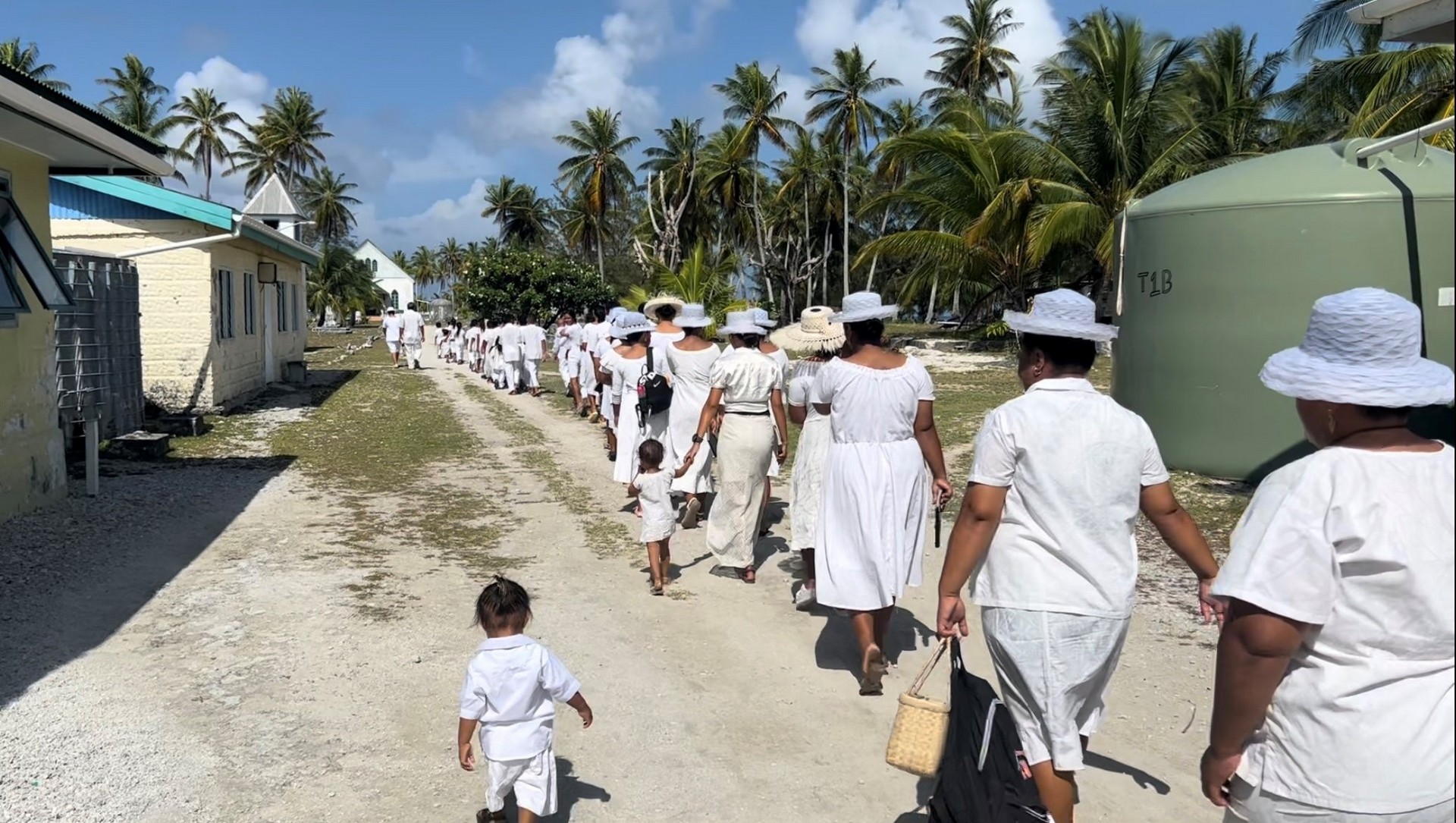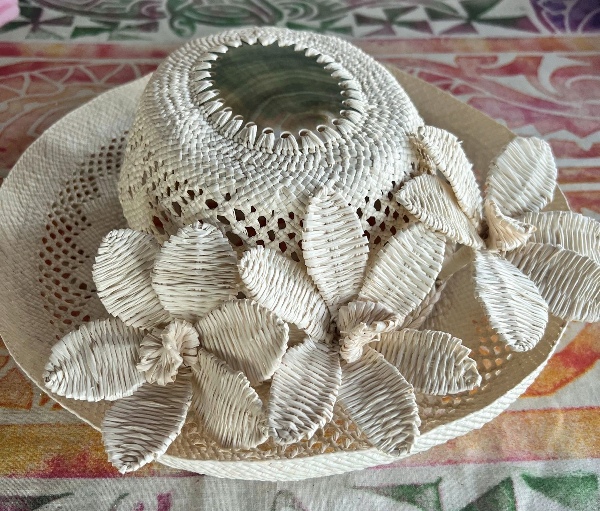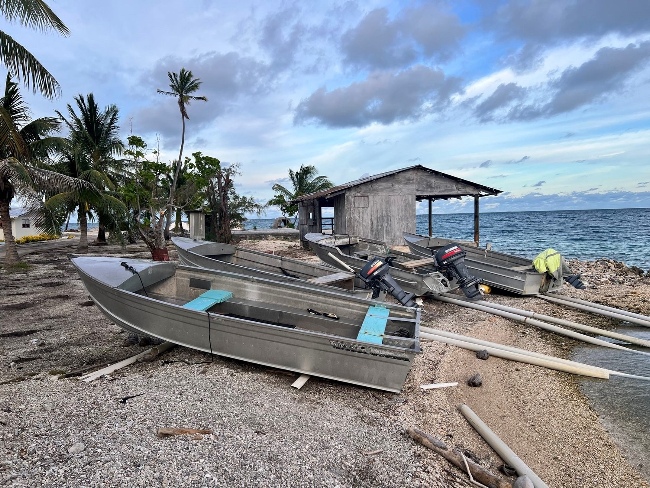DAILY LIFE ON PENRHYN
An outsider's insight
As one of the remotest places on the planet visitors to Penrhyn - aka Tongareva - are rare, but Tom Robinson from Brisbane, Australia was 24 when he landed there by chance. He spent four months on the island while rowing single-handed across the Pacific (yes, you read that right!).

He provides a unique insight into life on the Northern Group island which is 1,365 kms north by north east of Rarotonga. This is just a small taste of what he's written on his website (A MUST READ) and shared with me in emails.
Thank you Tom for getting in touch
THE CHURCH
"In every facet of life"
Omoka - the larger of the island's two villages - has two churches, a large and
well attended CICC church to which most people belong, and a smaller Catholic Church. Tetoutua, the
eastern village, is home to one CICC church and both villages have a Sunday
school. The
members of the CICC church attend up to five times a week. First on Wednesday
morning at six o’clock, then Friday morning at six, and three times on Sunday;
at six, ten and four. Sunday school is attended twice a week, before the ten
o’clock and four o’clock Sunday services.
"The church is not just a building or
a ritual. On Penrhyn, the Christian faith permeates every facet of life, from
home to school to work and everything in between. Even the arrival of a plane
must include a prayer from the reverend and singing, to welcome the new
arrivals. The people are united by a common path and belief, they share a level
of love and compassion through God that is oh so rare in my culture"

“Here we all believe in God, that’s
why everyone is happy.”
Sinaroa Teaurere, the Reverend of the Tetoutua church
FOOD FOR THOUGHT
"Fish, rice and coconut make up a significant portion of this diet. Being a coral atoll, the land is quite infertile, which means that growing fruit or vegetables is very hard. The coconut is the only tree that flourishes here, the breadfruit (kuru) grows in very small quantities, as does banana, mango tomato and a handful of others. Tinned beef is also a favourite of the islanders, despite its high cost and low quality! Bread and cakes are baked by most of the women on the island. Each family has to order their food from Rarotonga, and wait for it to be delivered by the supply ship that comes every few months. There is a small shop on the island, really just a room in Papa Moana’s house, that sells essentials and a few sweets, at great expense, and there is no guarantee that there will be stock. I once enquired about the opening hours of the Papa’s shop, “Oh when he is awake the shop is open”

FOOD FOR SURVIVAL

"Every three months, sometimes less, sometimes more, a new day dawns on Tongareva, and there’s a sense in the air that it’s going to be a good day. The day the ship arrives...All day the village worked, unloading everything imaginable for a settlement. There were building materials, outboard motors, bicycles and motorbikes, freezers, mattresses, and sacks of rice, flour and sugar - the essentials. There was no furniture unloaded; if needed, it would be made from the pallets and packing cases that held the sacks of rice. Nobody on the island ever knows when their specific bags of rice, flour and sugar will be unloaded, hence they must stay put, close by, all day, at the ready.he most excitement came with the unloading of the refrigerated containers: cardboard boxes of beef and chicken were set ashore, and then came the ice-cream. A sensation is almost unheard of on Penrhyn, but the closest thing I’ve seen so far is the unloading of the ice-cream, a treat universally loved amongst the village"
TRADITIONAL CRAFTING
The making of rito (lee-toe) hats is a tradition dating back to the 19th century and the finest are said to be made on Penrhyn. It involves by weaving fibres from new, unopened, coconut palm fronds. Through stripping,
cleaning, boiling and dying, the leaves of the fronds are prepared into fibres
that are then expertly woven over a wooden mould to produce an exquisite hat. Tom says every single adult woman on the
island is currently making a Rito hat and every young girl also learns the skill.

"
At any communal gathering on Penrhyn
you will find women weaving their hats; be it singing practice, a feast, or any
other event, a continuous cycle of weaving is achieved. The other day I was at
a birthday party, after the meal the men took their chairs outside and sat in a
loose circle and chatted the evening away. The women laid a mat on the ground
and all pulled out partly constructed Rito hats from their dedicated bags. Some
had just started and were yet to fasten the shell and partly woven top to the
mould, others were working on the intricate patterns, and some were weaving
leaves or flowers. They were all chatting happily as they worked, it was like
second nature. Even the women here who have full time jobs, either teaching at
the school or sewing for the island government will still have a hat or two
under construction, always at hand for when there is a spare moment."
FISHING
"An integral role in Island life"
Almost every adult male has a boat. They're are almost
exclusively aluminium dinghies (skiffs/tinnies) in the 14 to 16 foot range and powered by outboard motors of 15 to 40
horsepower. They sit on the beach and are taken in and out of the water by
hand each day. Some are over 30 years old and when they crack they're repaired with aluminium from the remains of a an American B24 bomber which crashed on the island in World War II. (READ THE STORY ABOUT IT HERE). There are numerous
different fishing techniques employing a range of traditional and modern equipment. Tom went out in a boat with Maru and experienced pole fishing,
trolling, and spearing. Once in the lagoon, and after a prayer, the pole fishing began...

"The motor is started and I’m ready with the anchor. On the signal I
drop it into the clear water and it bites onto the coral. Maru begins to chop
up some fish into small chunks, this will be berley and bait. I grab one of the
rods, a stiff three foot hardwood branch with a line of equal length tied to
the tip. On the end of the line is a small hook. Maru is leaning over the side,
massaging the berley in his hand, watching the trail of meat drift away. Sharks
appear, as they always do on Penrhyn. “Don’t put your line in the water until I
say.” Then, a few minutes later, we see the loohi (black trevally) appear.
“Now”. I drop my baited hook in the water and then, a few seconds later, a
healthy fish is hanging from my rod. We both whoop and cheer as it lands in the
boat. We continue on in this fashion, Maru eventually picks up his rod too, and
we’re both pulling in nice loohi"
Extracts reproduced with Tom's permission. Photos are his copyright





